tow TOYOTA PRIUS PRIME 2019 Owners Manual (in English)
[x] Cancel search | Manufacturer: TOYOTA, Model Year: 2019, Model line: PRIUS PRIME, Model: TOYOTA PRIUS PRIME 2019Pages: 792, PDF Size: 17.18 MB
Page 3 of 792
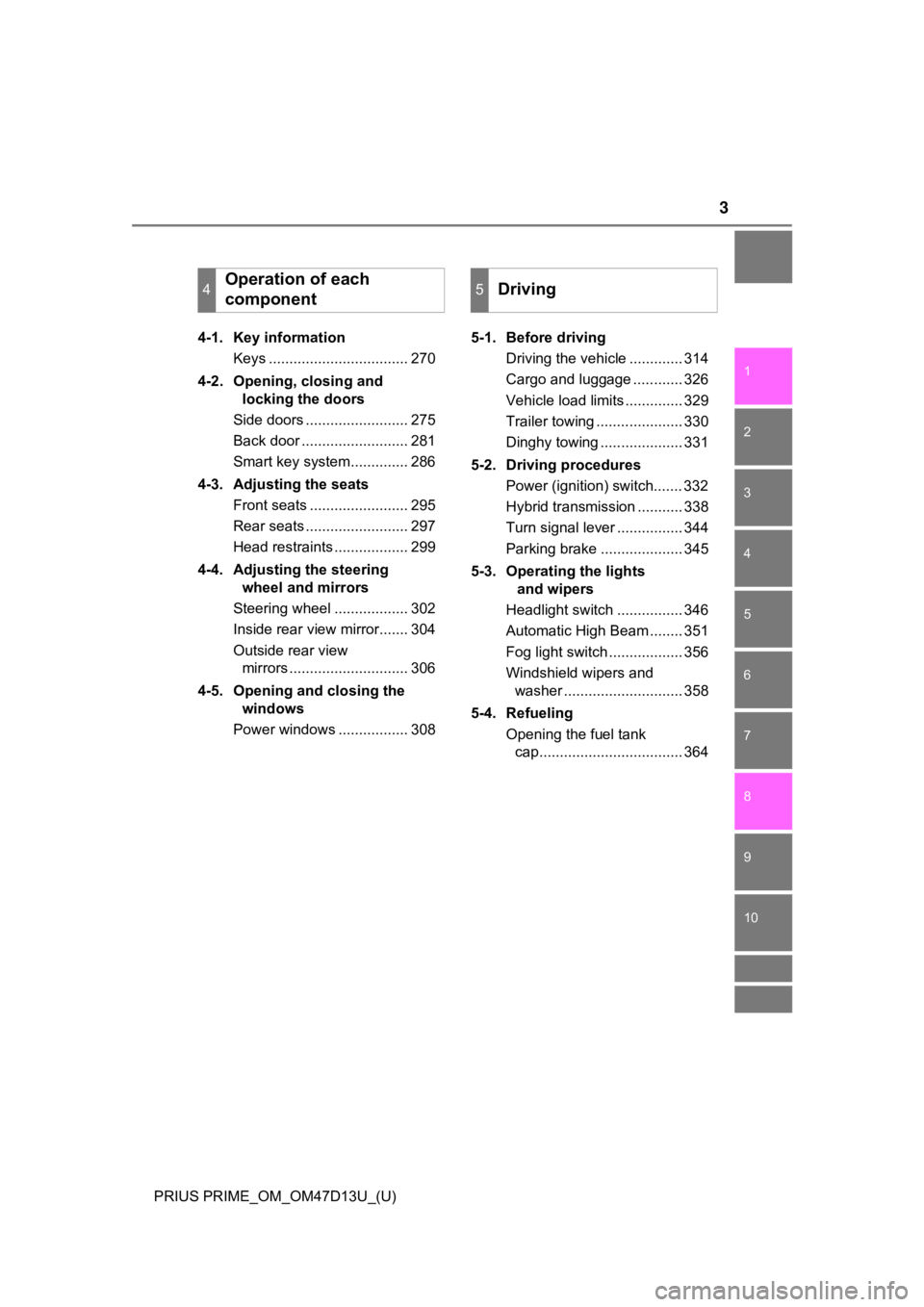
3
1
9 8
7
6 4 3
2
PRIUS PRIME_OM_OM47D13U_(U)
10
5
4-1. Key informationKeys .................................. 270
4-2. Opening, closing and locking the doors
Side doors ......................... 275
Back door .......................... 281
Smart key system.............. 286
4-3. Adjusting the seats Front seats ........................ 295
Rear seats ......................... 297
Head restraints .................. 299
4-4. Adjusting the steering wheel and mirrors
Steering wheel .................. 302
Inside rear view mirror....... 304
Outside rear view mirrors ............................. 306
4-5. Opening and closing the windows
Power windows ................. 308 5-1. Before driving
Driving the vehicle ............. 314
Cargo and luggage ............ 326
Vehicle load limits .............. 329
Trailer towing ..................... 330
Dinghy towing .................... 331
5-2. Driving procedures Power (ignition) switch....... 332
Hybrid transmission ........... 338
Turn signal lever ................ 344
Parking brake .................... 345
5-3. Operating the lights and wipers
Headlight switch ................ 346
Automatic High Beam ........ 351
Fog light switch .................. 356
Windshield wipers and washer ............................. 358
5-4. Refueling Opening the fuel tank cap................................... 364
4Operation of each
component5Driving
Page 6 of 792
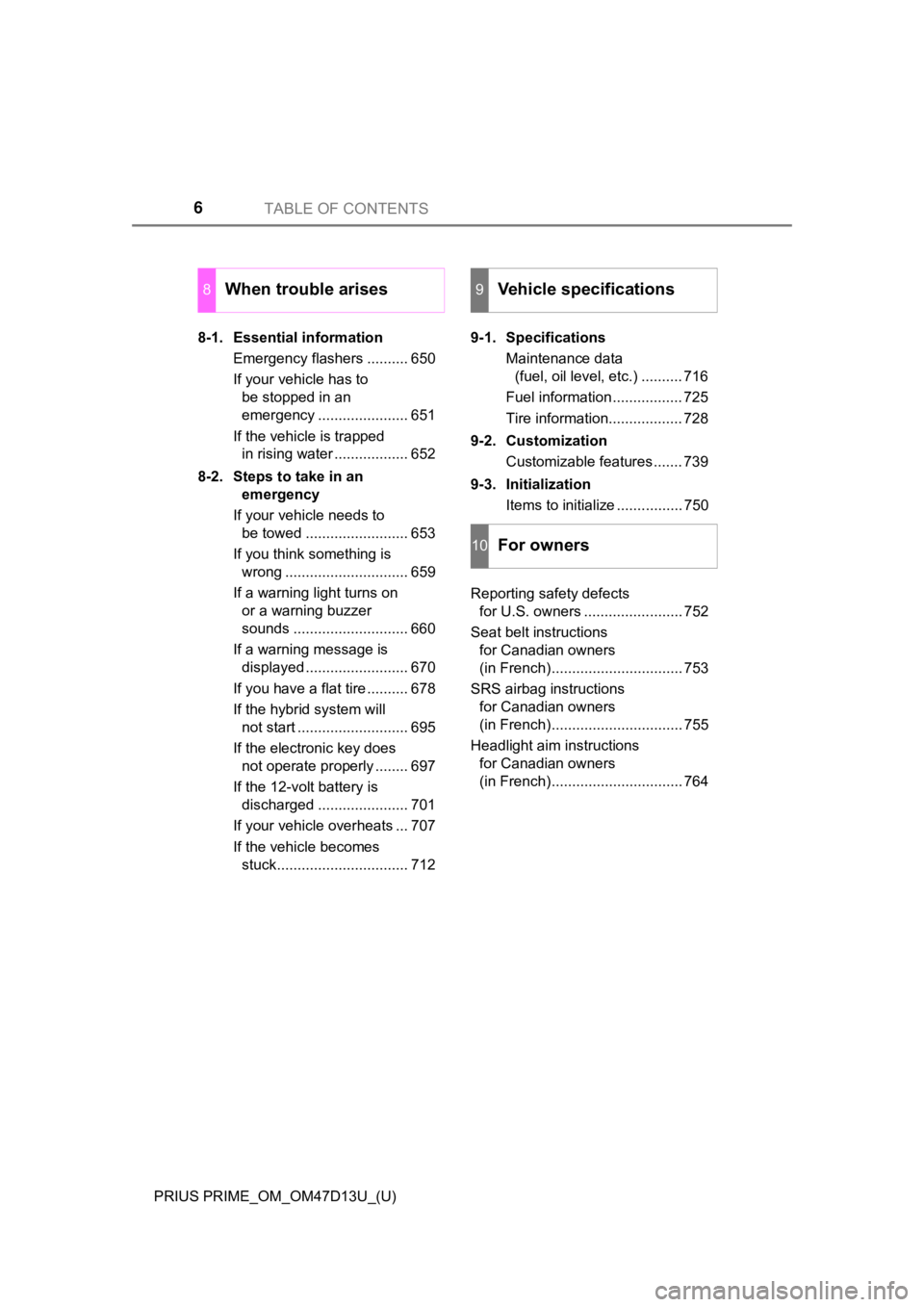
TABLE OF CONTENTS6
PRIUS PRIME_OM_OM47D13U_(U)8-1. Essential information
Emergency flashers .......... 650
If your vehicle has to be stopped in an
emergency ...................... 651
If the vehicle is trapped in rising water .................. 652
8-2. Steps to take in an emergency
If your vehicle needs to be towed ......................... 653
If you think something is wrong .............................. 659
If a warning light turns on or a warning buzzer
sounds ............................ 660
If a warning message is displayed ......................... 670
If you have a flat tire .......... 678
If the hybrid system will not start ........................... 695
If the electronic key does not operate properly ........ 697
If the 12-volt battery is discharged ...................... 701
If your vehicle overheats ... 707
If the vehicle becomes stuck................................ 712 9-1. Specifications
Maintenance data (fuel, oil level, etc.) .......... 716
Fuel information ................. 725
Tire information.................. 728
9-2. Customization Customizable features ....... 739
9-3. Initialization Items to initialize ................ 750
Reporting safety defects for U.S. owners ........................ 752
Seat belt instructions for Canadian owners
(in French)................................ 753
SRS airbag instructions for Canadian owners
(in French)................................ 755
Headlight aim instructions for Canadian owners
(in French)................................ 764
8When trouble arises9Vehicle specifications
10For owners
Page 18 of 792
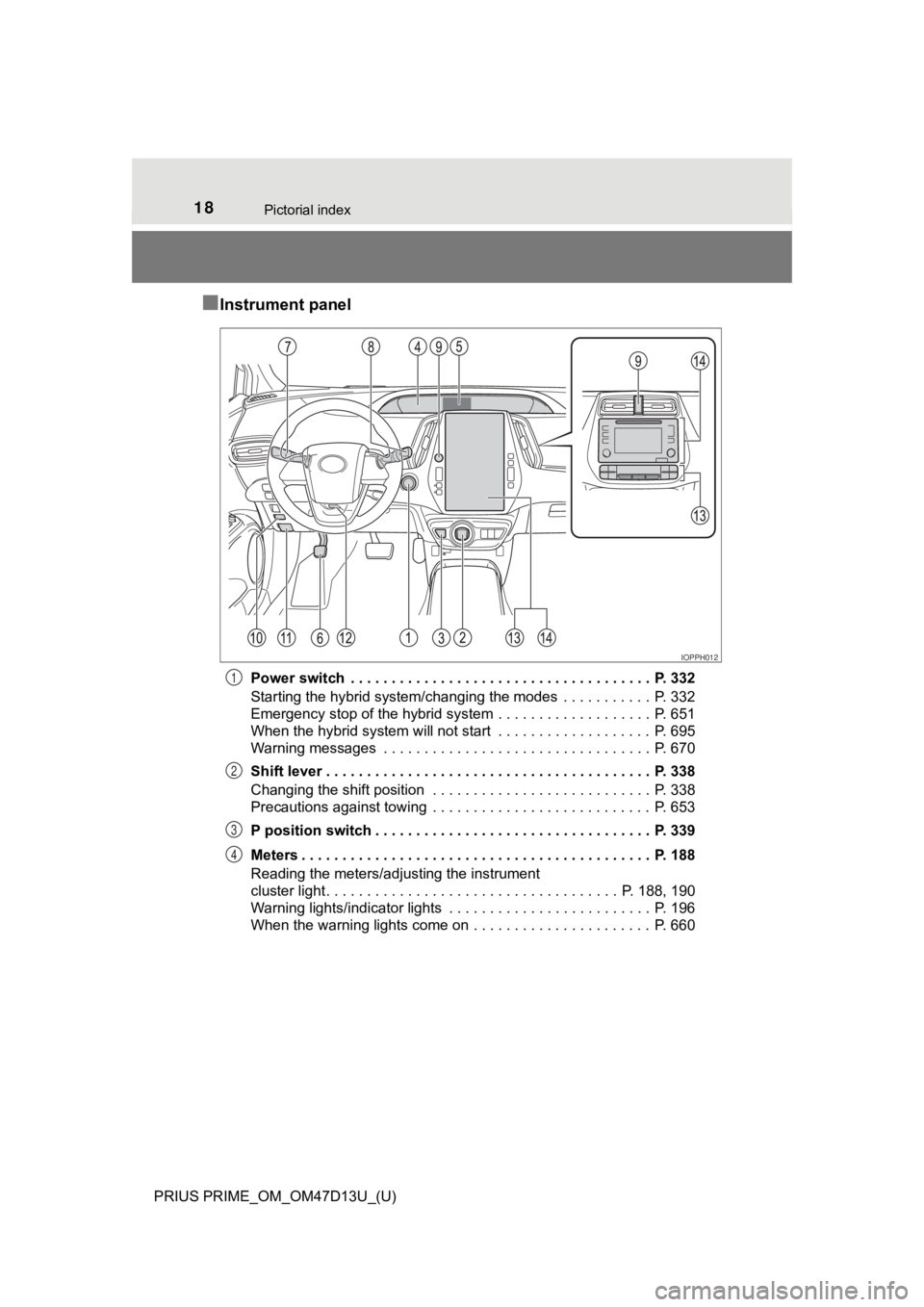
18Pictorial index
PRIUS PRIME_OM_OM47D13U_(U)
■Instrument panel
Power switch . . . . . . . . . . . . . . . . . . . . . . . . . . . . . . . . . . . . . P. 332
Starting the hybrid system/changing the modes . . . . . . . . . . . P. 332
Emergency stop of the hybrid system . . . . . . . . . . . . . . . . . . . P. 651
When the hybrid system will not start . . . . . . . . . . . . . . . . . . . P. 695
Warning messages . . . . . . . . . . . . . . . . . . . . . . . . . . . . . . . . . P. 670
Shift lever . . . . . . . . . . . . . . . . . . . . . . . . . . . . . . . . . . . . . . . . P. 338
Changing the shift position . . . . . . . . . . . . . . . . . . . . . . . . . . . P. 338
Precautions against towing . . . . . . . . . . . . . . . . . . . . . . . . . . . P. 653
P position switch . . . . . . . . . . . . . . . . . . . . . . . . . . . . . . . . . . P. 339
Meters . . . . . . . . . . . . . . . . . . . . . . . . . . . . . . . . . . . . . . . . . . . P. 188
Reading the meters/adjusting the instrument
cluster light . . . . . . . . . . . . . . . . . . . . . . . . . . . . . . . . . . . . P. 188, 190
Warning lights/indicator lights . . . . . . . . . . . . . . . . . . . . . . . . . P. 196
When the warning lights come on . . . . . . . . . . . . . . . . . . . . . . P. 660
IOPPH012
1
2
3
4
Page 39 of 792
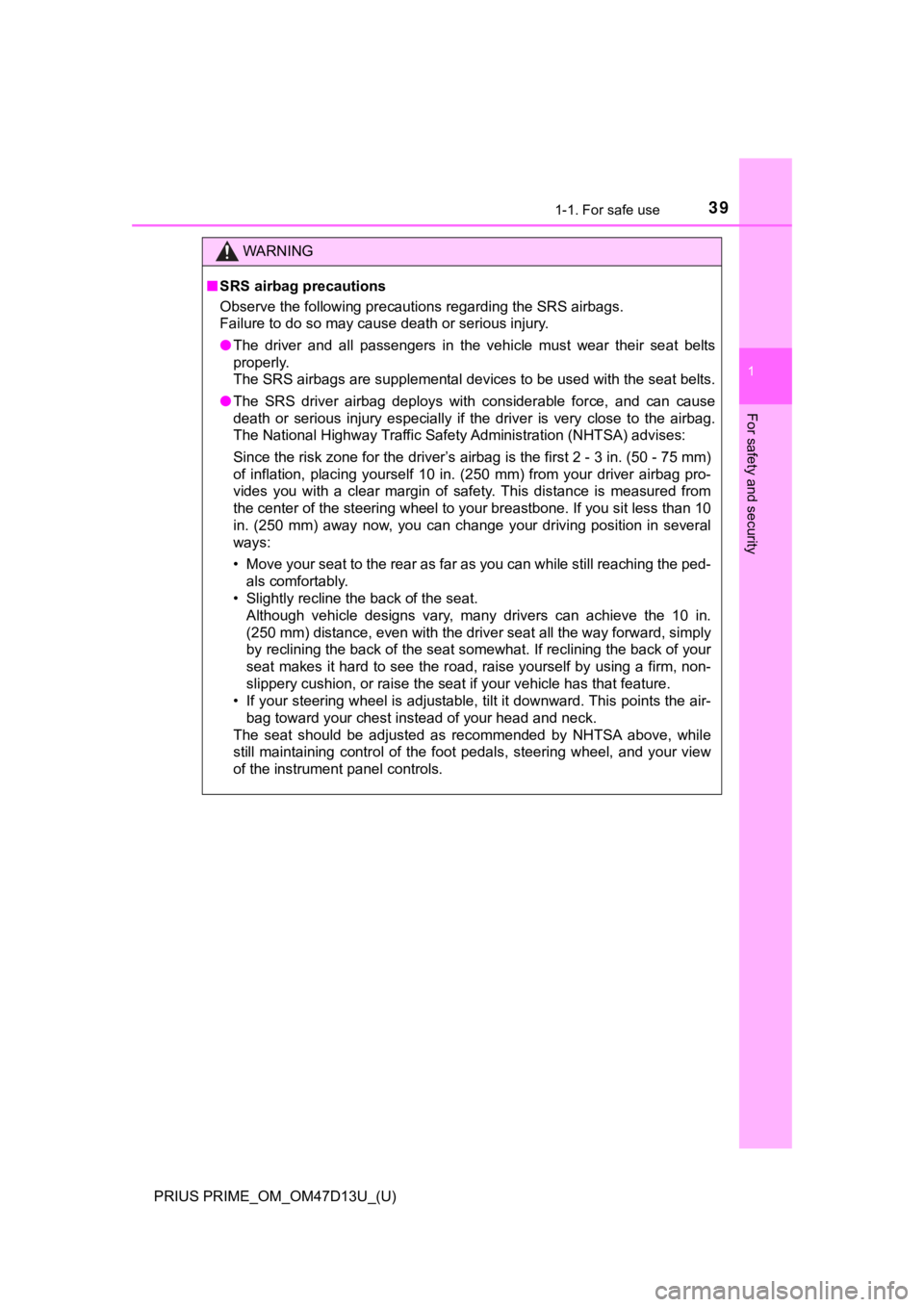
391-1. For safe use
PRIUS PRIME_OM_OM47D13U_(U)
1
For safety and security
WARNING
■SRS airbag precautions
Observe the following precautions regarding the SRS airbags.
Failure to do so may cause death or serious injury.
● The driver and all passengers in the vehicle must wear their se at belts
properly.
The SRS airbags are supplemental devices to be used with the se at belts.
● The SRS driver airbag deploys with considerable force, and can cause
death or serious injury especially if the driver is very close to the airbag.
The National Highway Traffic Safety Administration (NHTSA) advi ses:
Since the risk zone for the driver’s airbag is the first 2 - 3 in. (50 - 75 mm)
of inflation, placing yourself 10 in. (250 mm) from your driver airbag pro-
vides you with a clear margin of safety. This distance is measured from
the center of the steering wheel to your breastbone. If you sit less than 10
in. (250 mm) away now, you can change your driving position in several
ways:
• Move your seat to the rear as far as you can while still reach ing the ped-
als comfortably.
• Slightly recline the back of the seat. Although vehicle designs vary, many drivers can achieve the 10 in.
(250 mm) distance, even with the driver seat all the way forward , simply
by reclining the back of the seat somewhat. If reclining the ba ck of your
seat makes it hard to see the road, raise yourself by using a f irm, non-
slippery cushion, or raise the seat if your vehicle has that feature.
• If your steering wheel is adjustable, tilt it downward. This points the air- bag toward your chest instead of your head and neck.
The seat should be adjusted as recommended by NHTSA above, whil e
still maintaining control of the foot pedals, steering wheel, and your view
of the instrument panel controls.
Page 41 of 792
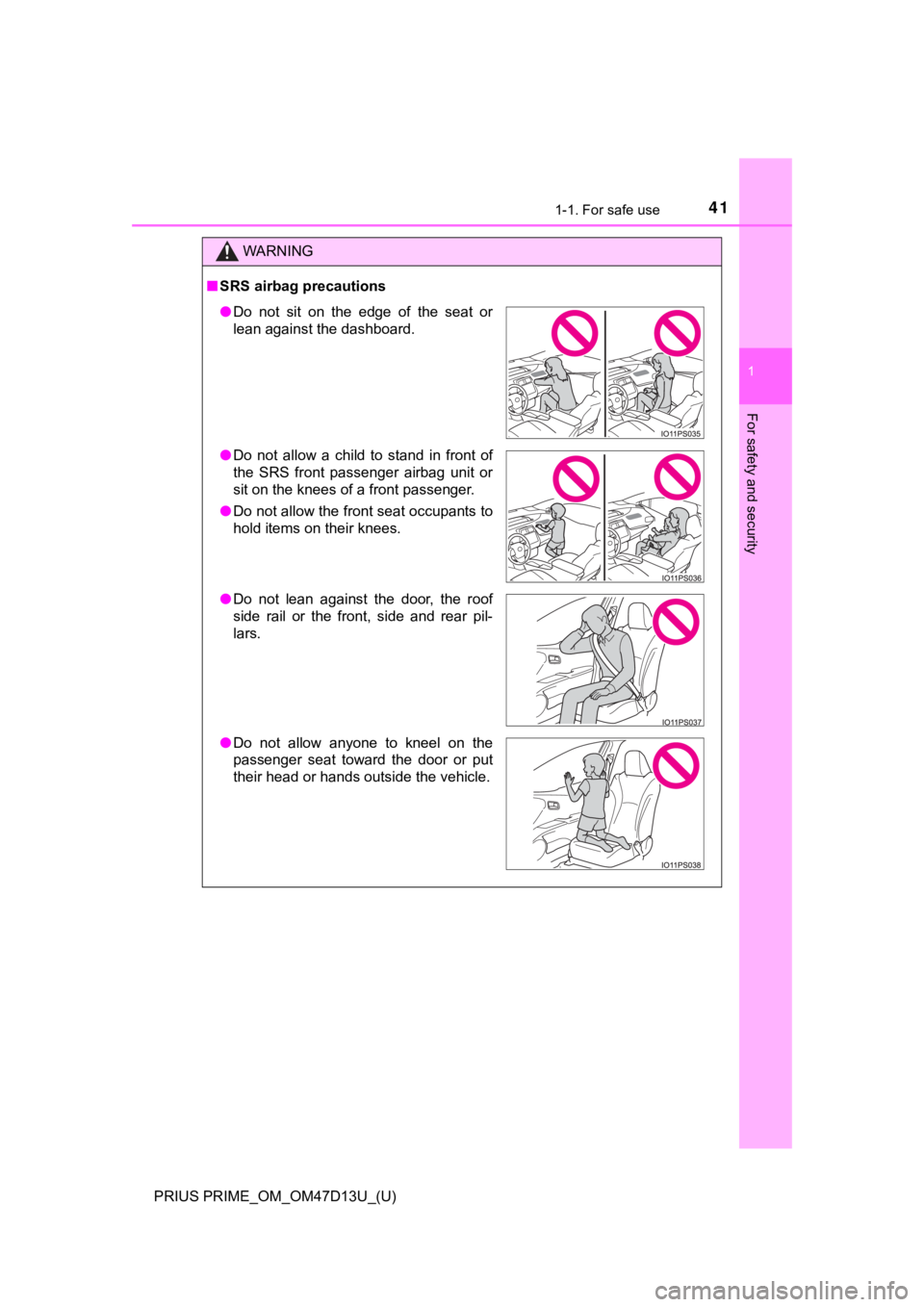
411-1. For safe use
PRIUS PRIME_OM_OM47D13U_(U)
1
For safety and security
WARNING
■SRS airbag precautions
● Do not sit on the edge of the seat or
lean against the dashboard.
● Do not allow a child to stand in front of
the SRS front passenger airbag unit or
sit on the knees of a front passenger.
● Do not allow the front seat occupants to
hold items on their knees.
● Do not lean against the door, the roof
side rail or the front, side and rear pil-
lars.
● Do not allow anyone to kneel on the
passenger seat toward the door or put
their head or hands outside the vehicle.
Page 68 of 792
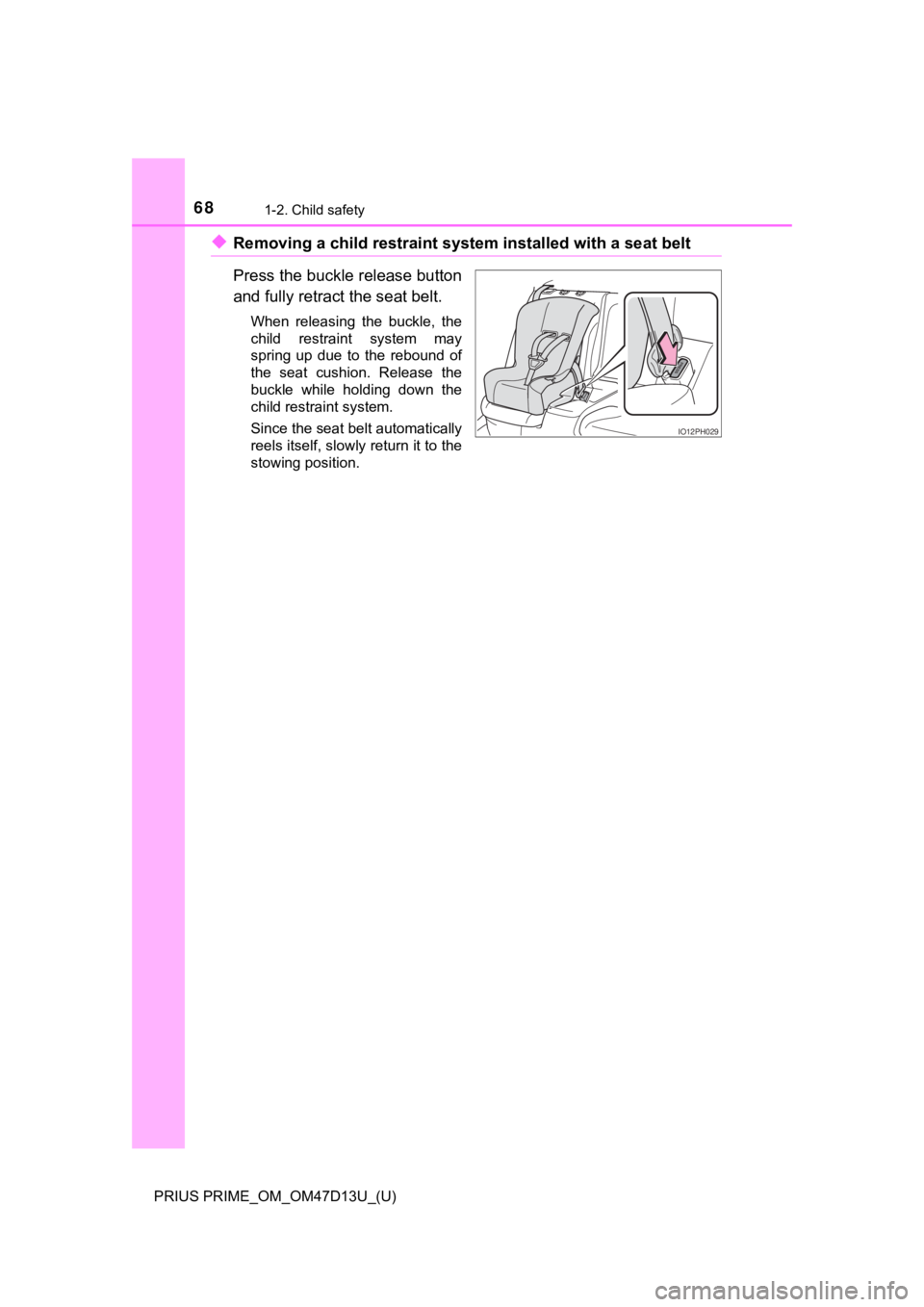
681-2. Child safety
PRIUS PRIME_OM_OM47D13U_(U)
◆Removing a child restraint system installed with a seat belt
Press the buckle release button
and fully retract the seat belt.
When releasing the buckle, the
child restraint system may
spring up due to the rebound of
the seat cushion. Release the
buckle while holding down the
child restraint system.
Since the seat belt automatically
reels itself, slowly return it to the
stowing position.
IO12PH029
Page 79 of 792
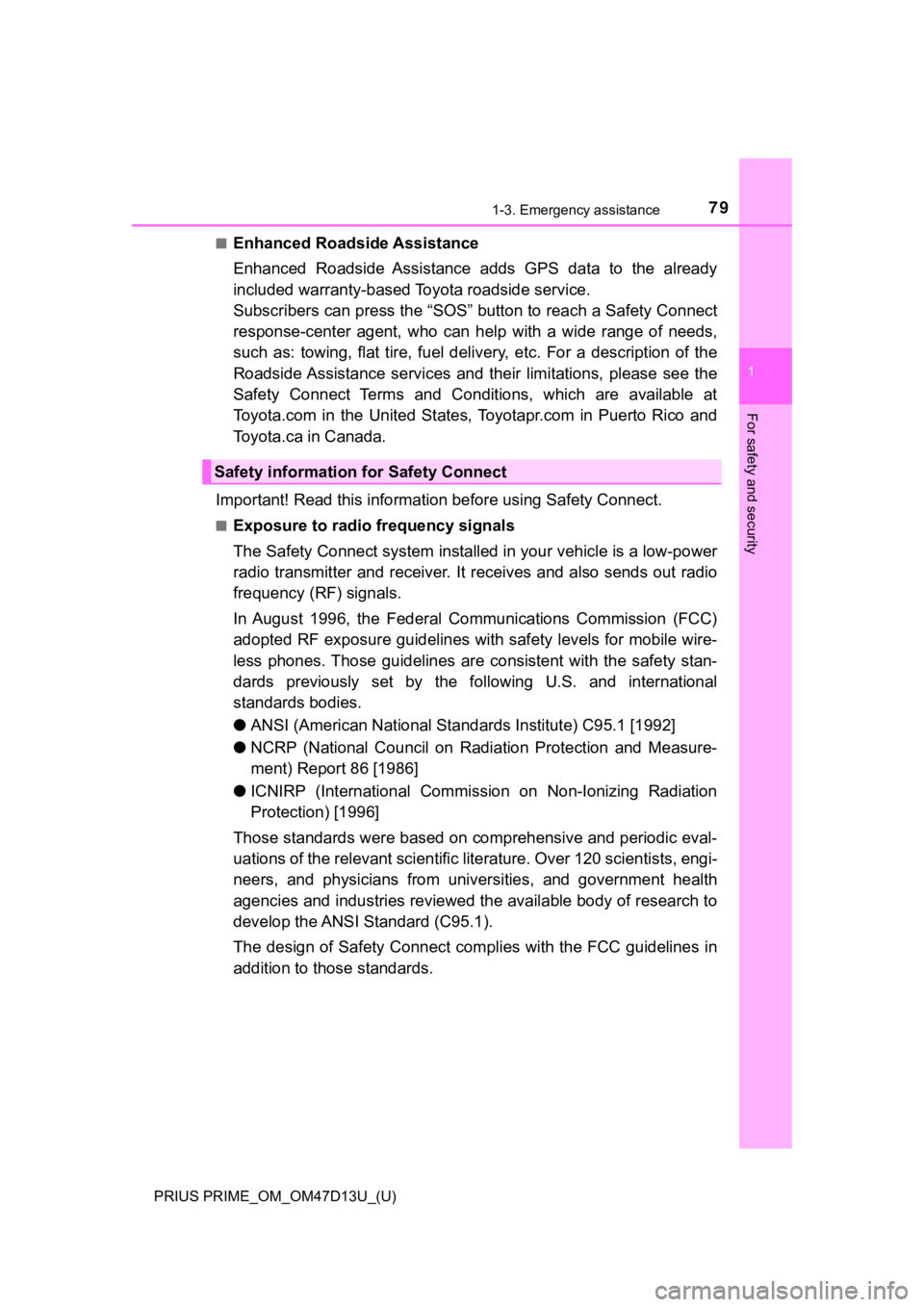
791-3. Emergency assistance
PRIUS PRIME_OM_OM47D13U_(U)
1
For safety and security
■Enhanced Roadside Assistance
Enhanced Roadside Assistance adds GPS data to the already
included warranty-based Toyota roadside service.
Subscribers can press the “SOS” button to reach a Safety Connec t
response-center agent, who can he lp with a wide range of needs,
such as: towing, flat tire, fuel delivery, etc. For a description of the
Roadside Assistance services an d their limitations, please see the
Safety Connect Terms and Conditions, which are available at
Toyota.com in the United States, Toyotapr.com in Puerto Rico an d
Toyota.ca in Canada.
Important! Read this informatio n before using Safety Connect.
■Exposure to radio frequency signals
The Safety Connect system installed in your vehicle is a low-po wer
radio transmitter and receiver. I t receives and also sends out radio
frequency (RF) signals.
In August 1996, the Federal Communications Commission (FCC)
adopted RF exposure guidelines with safety levels for mobile wi re-
less phones. Those guidelines are consistent with the safety stan-
dards previously set by the following U.S. and international
standards bodies.
● ANSI (American National Stand ards Institute) C95.1 [1992]
● NCRP (National Council on Radi ation Protection and Measure-
ment) Report 86 [1986]
● ICNIRP (International Commission on Non-Ionizing Radiation
Protection) [1996]
Those standards were based on comprehensive and periodic eval-
uations of the relevant scienti fic literature. Over 120 scientists, engi-
neers, and physicians from unive rsities, and government health
agencies and industries reviewed the available body of research to
develop the ANSI Standard (C95.1).
The design of Safety Connect complies with the FCC guidelines i n
addition to those standards.
Safety information for Safety Connect
Page 100 of 792
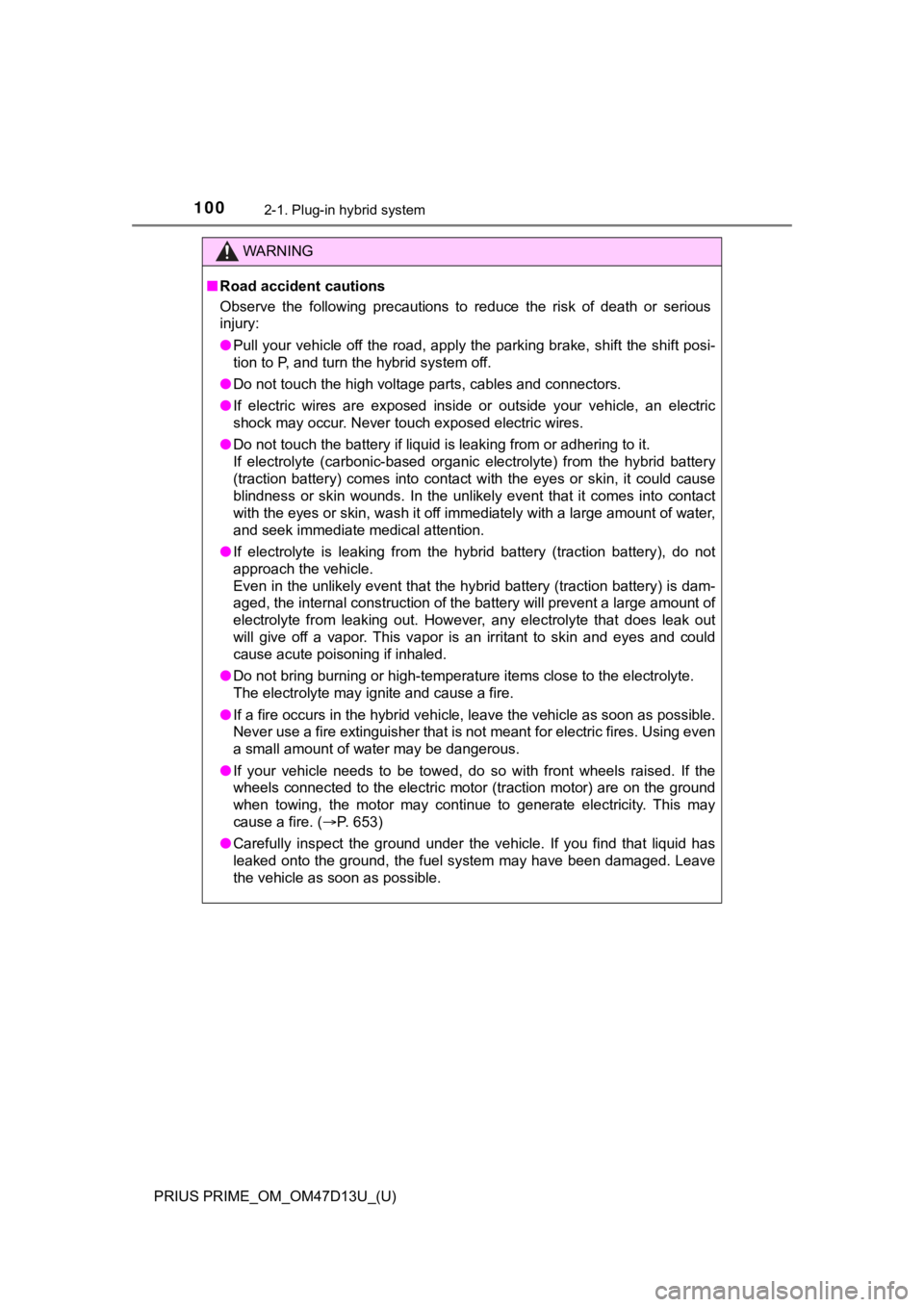
100
PRIUS PRIME_OM_OM47D13U_(U)
2-1. Plug-in hybrid system
WARNING
■Road accident cautions
Observe the following precautions to reduce the risk of death o r serious
injury:
● Pull your vehicle off the road, apply the parking brake, shift the shift posi-
tion to P, and turn the hybrid system off.
● Do not touch the high voltage parts, cables and connectors.
● If electric wires are exposed inside or outside your vehicle, an electric
shock may occur. Never touch exposed electric wires.
● Do not touch the battery if liquid is leaking from or adhering to it.
If electrolyte (carbonic-based organic electrolyte) from the hy brid battery
(traction battery) comes into contact with the eyes or skin, it could cause
blindness or skin wounds. In the unlikely event that it comes into contact
with the eyes or skin, wash it off immediately with a large amount of water,
and seek immediate medical attention.
● If electrolyte is leaking from the hybrid battery (traction bat tery), do not
approach the vehicle.
Even in the unlikely event that the hybrid battery (traction ba ttery) is dam-
aged, the internal construction of the battery will prevent a l arge amount of
electrolyte from leaking out. However, any electrolyte that doe s leak out
will give off a vapor. This vapor is an irritant to skin and eyes and could
cause acute poisoning if inhaled.
● Do not bring burning or high-tem perature items close to the electrolyte.
The electrolyte may ignite and cause a fire.
● If a fire occurs in the hybrid vehicle, leave the vehicle as soon as possible.
Never use a fire extinguisher that is not meant for electric fires. Using even
a small amount of water may be dangerous.
● If your vehicle needs to be towed, do so with front wheels raised. If the
wheels connected to the electric motor (traction motor) are on the ground
when towing, the motor may continue to generate electricity. Th is may
cause a fire. ( P. 653)
● Carefully inspect the ground under the vehicle. If you find that liquid has
leaked onto the ground, the fuel system may have been damaged. Leave
the vehicle as soon as possible.
Page 147 of 792
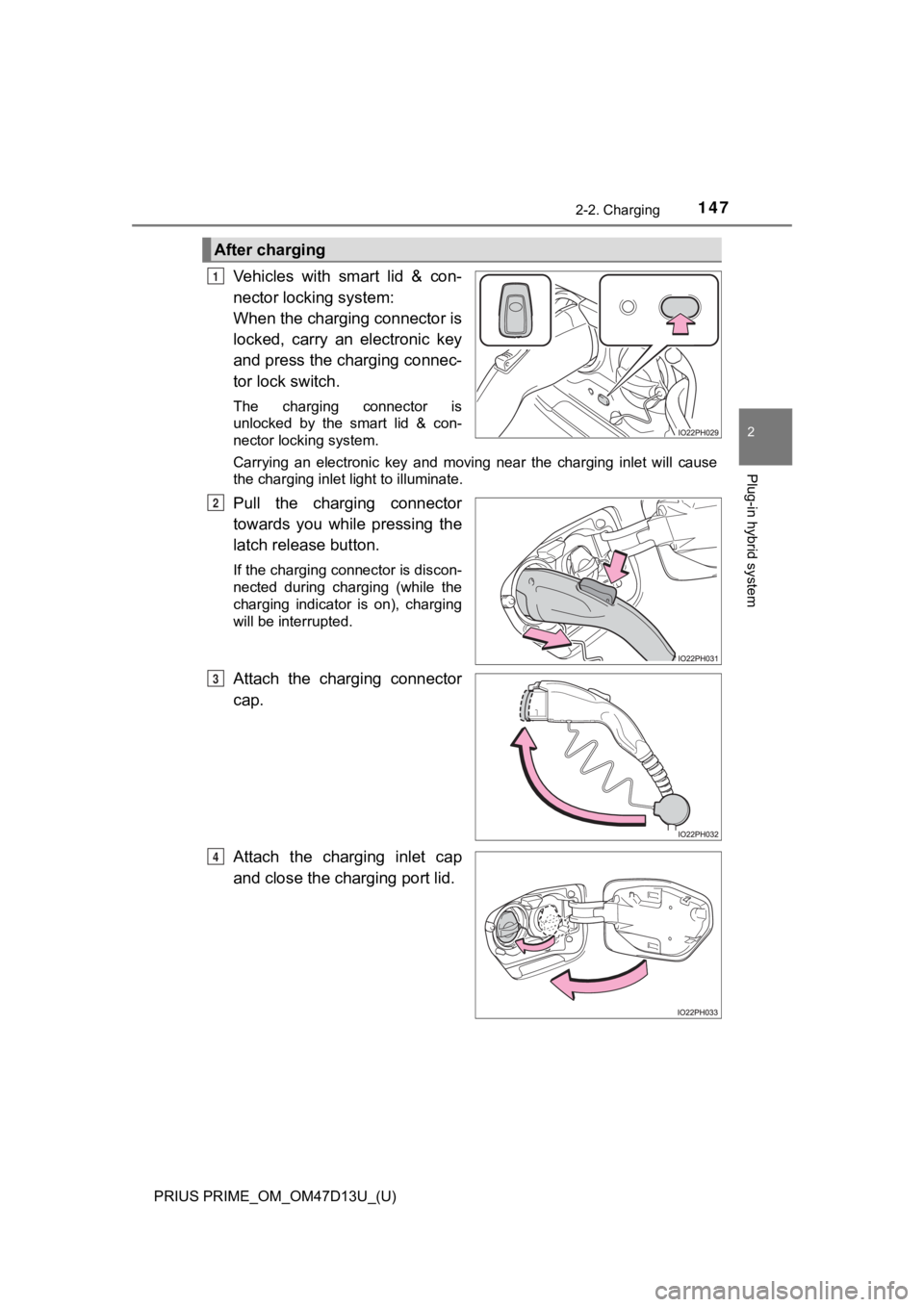
PRIUS PRIME_OM_OM47D13U_(U)
1472-2. Charging
2
Plug-in hybrid system
Vehicles with smart lid & con-
nector locking system:
When the charging connector is
locked, carry an electronic key
and press the charging connec-
tor lock switch.
The charging connector is
unlocked by the smart lid & con-
nector locking system.
Carrying an electronic key and moving near the charging inlet will cause
the charging inlet light to illuminate.
Pull the charging connector
towards you while pressing the
latch release button.
If the charging connector is discon-
nected during charging (while the
charging indicator is on), charging
will be interrupted.
Attach the charging connector
cap.
Attach the charging inlet cap
and close the charging port lid.
After charging
1
2
3
4
Page 149 of 792
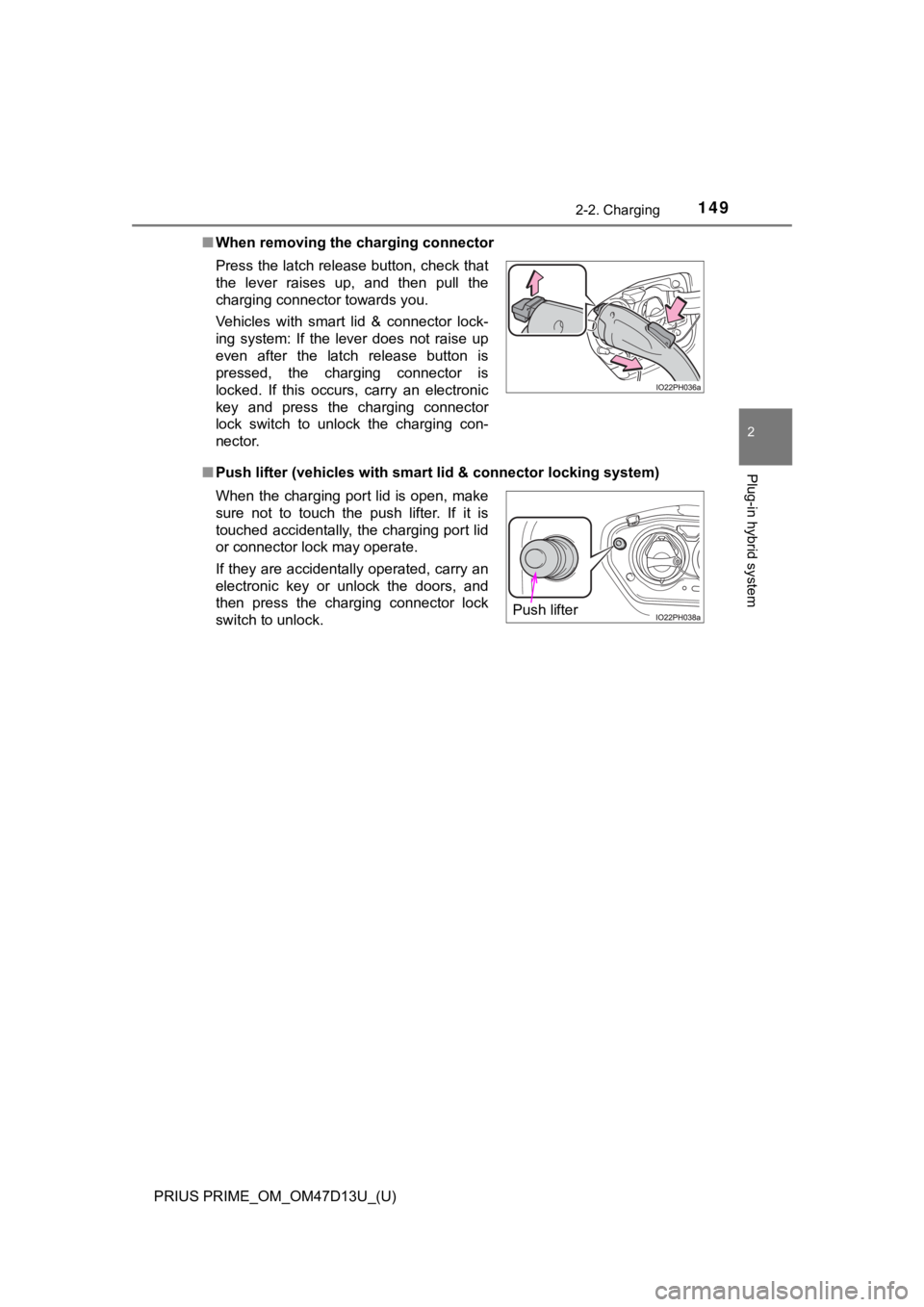
PRIUS PRIME_OM_OM47D13U_(U)
1492-2. Charging
2
Plug-in hybrid system
■When removing the charging connector
■ Push lifter (vehicles with smart lid & connector locking system )
Press the latch release button, check that
the lever raises up, and then pull the
charging connector towards you.
Vehicles with smart lid & connector lock-
ing system: If the lever does not raise up
even after the latch release button is
pressed, the charging connector is
locked. If this occurs, carry an electronic
key and press the charging connector
lock switch to unlock the charging con-
nector.
When the charging port lid is open, make
sure not to touch the push lifter. If it is
touched accidentally, the charging port lid
or connector lock may operate.
If they are accidentally operated, carry an
electronic key or unlock the doors, and
then press the charging connector lock
switch to unlock.
Push lifter